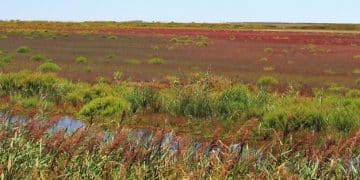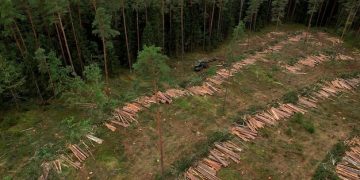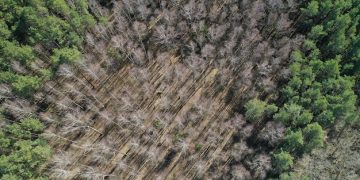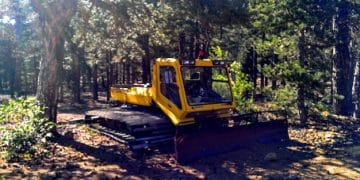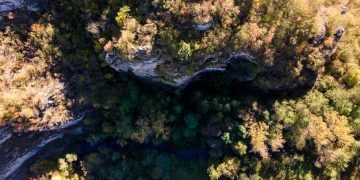Habitat Fragmentation: Impact on Wildlife and Mitigation Strategies
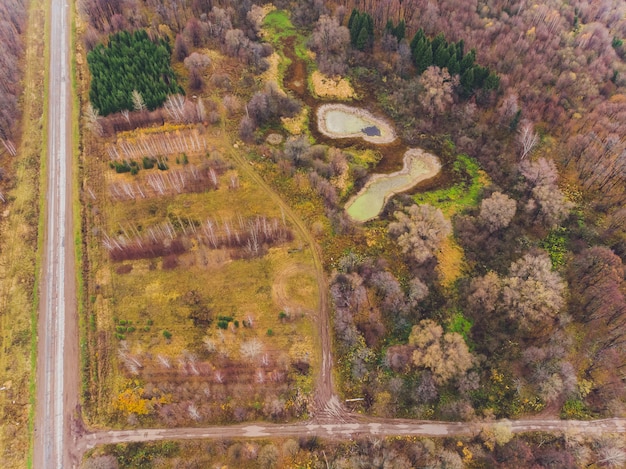
Habitat fragmentation disrupts ecosystems, isolating wildlife populations and reducing biodiversity, which necessitates strategic mitigation efforts like habitat restoration and creating wildlife corridors to reconnect fragmented areas.
Understanding how habitat fragmentation affects wildlife populations and what can be done to mitigate it is crucial for preserving biodiversity. As human activities continue to alter natural landscapes, wildlife faces increasing challenges in finding food, mates, and safe passage.
Understanding Habitat Fragmentation
Habitat fragmentation is the process by which large, continuous habitats are broken up into smaller, isolated patches. This can occur due to various human activities, such as deforestation, urbanization, and agriculture, leading to significant ecological consequences.
The primary cause of habitat fragmentation is land conversion. As human populations grow, there is an increasing demand for resources and space, leading to forests being cleared for farming, cities expanding, and roads cutting through natural areas. This division of habitats creates barriers that affect wildlife in numerous ways.
Causes of Habitat Fragmentation
Several factors contribute to habitat fragmentation, all of which stem from human activities. Understanding these causes is essential for developing effective conservation strategies.
- Deforestation: The clearing of forests for timber, agriculture, and development is a major driver of habitat fragmentation.
- Urbanization: The growth of cities and towns often involves converting natural habitats into built environments, leaving isolated patches of wildlife habitat.
- Agriculture: Farmlands can create barriers between natural areas, especially when intensive farming practices are used.
- Roads and Infrastructure: Roads, pipelines, and power lines can bisect habitats, creating barriers to movement and dispersal for many species.
Habitat fragmentation dramatically alters the landscape, impacting ecological processes and wildlife populations.
Impacts on Wildlife Populations
The effects of habitat fragmentation on wildlife are broad and can lead to significant declines in biodiversity. Isolated habitat patches can support smaller populations, making them more vulnerable to extinction.
Species requiring large home ranges or specific habitat conditions are particularly susceptible to the negative impacts of fragmentation. These species often struggle to find enough resources or mates in isolated patches, which reduces their survival rates.

Reduced Genetic Diversity
One of the most significant impacts of habitat fragmentation is the reduction of genetic diversity within wildlife populations. When populations are isolated, gene flow is restricted, leading to inbreeding and a loss of genetic variation.
This loss of genetic diversity can make populations more susceptible to diseases, environmental changes, and other threats, undermining their long-term survival.
Increased Edge Effects
Edge effects refer to the changes in environmental conditions that occur at the boundaries between different habitats. Fragmented habitats have a higher proportion of edge compared to interior, leading to altered microclimates, increased exposure to predators and invasive species, and changes in vegetation composition.
- Microclimate Changes: Edges often experience increased sunlight, wind, and temperature fluctuations, which can stress species adapted to more stable interior conditions.
- Increased Predation: Predators often concentrate along edges, leading to higher predation rates on prey species in fragmented habitats.
- Invasive Species: Edges can be more easily colonized by invasive species, which can outcompete native species and alter ecosystem structure.
Habitat fragmentation disrupts ecological processes and reduces the resilience of wildlife populations.
Population Dynamics in Fragmented Habitats
Habitat fragmentation affects various aspects of population dynamics, including population size, distribution, and dispersal patterns. Small, isolated populations are more likely to experience fluctuations and are at a higher risk of local extinction.
The ability of a species to move between habitat patches is crucial for maintaining viable populations. However, fragmentation can create barriers that limit dispersal, preventing individuals from accessing resources, finding mates, or recolonizing areas after disturbances.
Metapopulation Dynamics
In fragmented landscapes, populations often exist as metapopulations, which are networks of interconnected subpopulations. The dynamics of metapopulations depend on the balance between local extinctions and colonizations.
Habitat fragmentation can disrupt these dynamics by reducing the size and connectivity of habitat patches, increasing the risk of local extinctions and preventing recolonization.
Dispersal Barriers
Fragmentation can create significant barriers to dispersal, preventing animals from moving between habitat patches. These barriers can include roads, agricultural fields, and urban developments.
- Road Mortality: Roads can cause direct mortality as animals attempt to cross them, especially for species with slow reproductive rates.
- Habitat Isolation: Large agricultural fields or urban areas can completely isolate habitat patches, preventing movement and dispersal.
- Behavioral Avoidance: Some species may avoid crossing open areas due to the risk of predation or unfamiliarity, further limiting dispersal.
Mitigation Strategies: Habitat Restoration
Habitat restoration involves the process of repairing degraded or destroyed ecosystems to restore their ecological functions and biodiversity. This can include reforestation, wetland restoration, and the removal of invasive species.
Restoring habitats can increase the size and quality of available habitat, providing more resources and opportunities for wildlife populations to thrive. It can also improve connectivity between habitat patches, facilitating dispersal and gene flow.
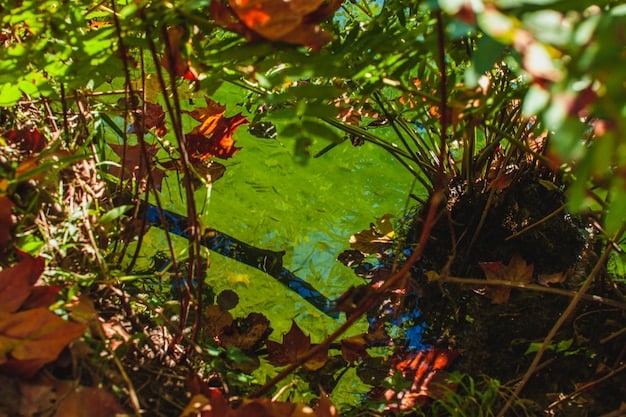
Reforestation and Afforestation
Reforestation involves replanting trees in areas that were previously forested, while afforestation involves planting trees in areas that were not previously forested. Both can help to expand habitat size and improve connectivity.
These efforts can create new habitats for wildlife, provide corridors for dispersal, and enhance the overall ecological value of fragmented landscapes.
Wetland Restoration
Wetlands are critical habitats for many species, providing essential breeding grounds, feeding areas, and refuge from predators. Restoring degraded wetlands can benefit a wide range of wildlife populations.
- Improved Water Quality: Wetland restoration can improve water quality by filtering pollutants and reducing sediment runoff.
- Increased Habitat Diversity: Restored wetlands can provide a variety of habitats for different species, enhancing biodiversity.
- Flood Control: Wetlands can help to control flooding by absorbing excess water during heavy rainfall events.
Habitat restoration is a crucial strategy for mitigating the negative impacts of fragmentation and promoting the recovery of wildlife populations.
Mitigation Strategies: Creating Wildlife Corridors
Wildlife corridors are areas of habitat that connect fragmented patches, allowing animals to move between them. These corridors can be natural features, such as riparian areas or ridgelines, or they can be created through restoration or conservation efforts.
Corridors can facilitate dispersal, gene flow, and access to resources, helping to maintain viable populations in fragmented landscapes. They can also reduce the risk of local extinctions by allowing animals to recolonize areas after disturbances.
Types of Wildlife Corridors
Wildlife corridors can take many forms, depending on the species and landscape in question. Some common types include:
Riparian corridors are vegetated areas along streams and rivers that provide habitat and connectivity for many species.
Road underpasses and overpasses create safe crossing points for animals, reducing road mortality and facilitating dispersal.
Green belts are areas of green space within or around urban areas that provide habitat and connectivity for wildlife.
Designing Effective Corridors
Designing effective wildlife corridors requires careful consideration of the species, habitats, and landscape context. Some key considerations include:
- Corridor Width: Corridors should be wide enough to provide adequate habitat and reduce edge effects. The optimal width will vary depending on the species and landscape.
- Habitat Quality: Corridors should provide high-quality habitat that meets the needs of the target species. This may involve restoring vegetation, managing predators, or reducing human disturbance.
- Connectivity: Corridors should effectively connect habitat patches, allowing animals to move freely between them. This may involve removing barriers, creating stepping-stone habitats, or restoring degraded areas.
These must be carefully planned and implemented to maximize their effectiveness in supporting wildlife populations.
Policy and Conservation Efforts
Addressing the issue of habitat fragmentation requires a combination of policy interventions, conservation initiatives, and public awareness campaigns. Governments, organizations, and individuals all have a role to play in protecting and restoring fragmented landscapes.
Effective policies can provide incentives for sustainable land management practices, protect critical habitats, and regulate development activities. Conservation initiatives can restore degraded habitats, create wildlife corridors, and monitor the health of wildlife populations.
Government Policies
Government policies can play a crucial role in mitigating habitat fragmentation. Some examples include:
Land-use planning regulations can guide development activities to minimize habitat loss and fragmentation.
Protected areas, such as national parks and wildlife refuges, can conserve large, intact habitats and provide refuge for wildlife populations.
Incentive programs can encourage landowners to adopt sustainable land management practices that protect and restore habitats.
Community Involvement
Engaging local communities in conservation efforts is essential for long-term success. Local communities often have valuable knowledge about the landscape and can play a key role in monitoring and managing habitats.
- Education Programs: Education programs can raise awareness about the importance of habitat conservation and encourage people to take action to protect wildlife.
- Volunteer Opportunities: Volunteer opportunities can engage people in hands-on conservation activities, such as tree planting, trail maintenance, and wildlife monitoring.
- Community-Based Conservation: Community-based conservation initiatives can empower local communities to manage and protect their natural resources.
The key to mitigating habitat fragmentation lies in collaborative efforts and proactive conservation strategies.
| Key Point | Brief Description |
|---|---|
| 🌳 Habitat Fragmentation | Division of large habitats into smaller, isolated patches due to human activities. |
| 📉 Reduced Genetic Diversity | Isolation restricts gene flow, leading to inbreeding and less resilience. |
| 🌿 Habitat Restoration | Repairing degraded ecosystems to restore ecological functions and biodiversity. |
| 🌉 Wildlife Corridors | Connecting fragmented habitats to allow animal movement and maintain viable populations. |
Frequently Asked Questions (FAQ)
▼
Habitat fragmentation is the division of large, continuous habitats into smaller, isolated patches. This process is often due to human activities such as deforestation, urbanization, and agriculture.
▼
Fragmentation reduces habitat size, isolates populations, and decreases genetic diversity. It also increases edge effects, making species more vulnerable to predation and invasive species.
▼
Wildlife corridors are areas of habitat that connect fragmented patches, allowing animals to move between them. They facilitate dispersal, gene flow, and access to resources.
▼
Habitat restoration involves repairing degraded or destroyed ecosystems to restore their ecological functions and biodiversity. This can include reforestation, wetland restoration, and invasive species removal.
▼
Mitigating fragmentation is crucial for preserving biodiversity, maintaining ecosystem health, and ensuring the long-term survival of many species. It helps support ecological balance and resilience.
Conclusion
Understanding and mitigating how habitat fragmentation affects wildlife populations and what can be done to mitigate it is vital for preserving biodiversity and ensuring the long-term health of ecosystems. Through strategies like habitat restoration and creating wildlife corridors, combined with effective policy and community involvement, we can reduce the detrimental impacts of fragmentation and support thriving wildlife populations.

